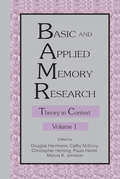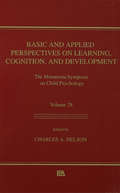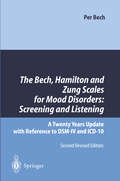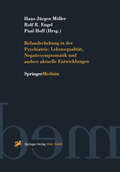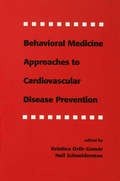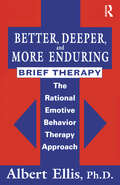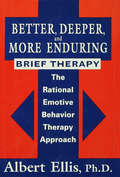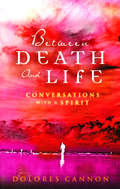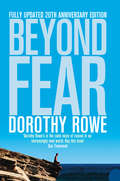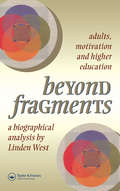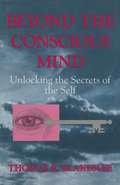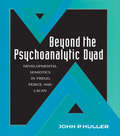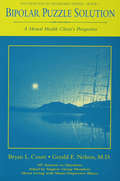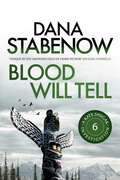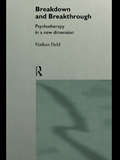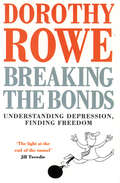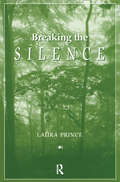- Table View
- List View
Basic and Applied Memory Research: Volume 1: Theory in Context; Volume 2: Practical Applications
by Douglas J. Herrmann Paula Hertel Chris Hertzog Cathy McEvoy Marcia K. JohnsonBasic researchers unlock the secrets of nature; applied researchers unlock the means by which those secrets of nature can change people's lives. Neither basic nor applied research has an independent impact. These volumes examine the convergence of basic and applied research in the field of memory. Volume 1: Theory and Context, focuses on the methods for understanding and applying basic memory theory, while Volume 2: Practical Applications, expands the understanding of practical memory research by providing in-depth research examples and findings. If the science of memory is to make a significant contribution to society, coordinating our basic and applied efforts and determining how they complement each other become of paramount importance. These volumes will help in this regard--both as textbooks demonstrating how to investigate memory and apply basic memory theory, and as reference sources leading to a better understanding of certain problems in basic and applied memory research. Readers of these volumes will gain a thorough grasp of the way major themes relate to basic and applied research collaboration, how programmatic basic and applied research can be conducted on particular memory problems, and the manner in which basic and applied work in major problem areas has been incorporated into the field of memory. Both volumes present important information that will be indispensable to researchers and students alike.
Basic and Applied Perspectives on Learning, Cognition, and Development: The Minnesota Symposia on Child Psychology, Volume 28 (Minnesota Symposia on Child Psychology Series)
by Charles A. NelsonAlthough current views of cognitive development owe a great deal to Jean Piaget, this field has undergone profound change in the years since Piaget's death. This can be witnessed both in the influence connectionist and dynamical system models have exerted on theories of cognition and language, and in how basic work in cognitive development has begun to influence those who work in applied (e.g., educational) settings. This volume brings together an eclectic group of distinguished experts who collectively represent the full spectrum of basic to applied aspects of cognitive development. This book begins with chapters on cognition and language that represent the current Zeitgeist in cognitive science approaches to cognitive development broadly defined. Following a brief commentary on this work, the next section turns to more applied issues. Although the focus here is on arithmetic learning, the research programs described have profound implications for virtually all aspects of education and learning. The last chapter views cognitive development from the perspective of ethology and evolutionary biology, and in so doing provides a theoretical perspective that is novel and in some ways, prescient: specifically, how can our views of cognition incorporate recent work in biology?
Basic and Applied Perspectives on Learning, Cognition, and Development: The Minnesota Symposia on Child Psychology, Volume 28 (Minnesota Symposia on Child Psychology Series #Vol. 28)
by Charles A. NelsonAlthough current views of cognitive development owe a great deal to Jean Piaget, this field has undergone profound change in the years since Piaget's death. This can be witnessed both in the influence connectionist and dynamical system models have exerted on theories of cognition and language, and in how basic work in cognitive development has begun to influence those who work in applied (e.g., educational) settings. This volume brings together an eclectic group of distinguished experts who collectively represent the full spectrum of basic to applied aspects of cognitive development. This book begins with chapters on cognition and language that represent the current Zeitgeist in cognitive science approaches to cognitive development broadly defined. Following a brief commentary on this work, the next section turns to more applied issues. Although the focus here is on arithmetic learning, the research programs described have profound implications for virtually all aspects of education and learning. The last chapter views cognitive development from the perspective of ethology and evolutionary biology, and in so doing provides a theoretical perspective that is novel and in some ways, prescient: specifically, how can our views of cognition incorporate recent work in biology?
The Bech, Hamilton and Zung Scales for Mood Disorders: A Twenty Years Update with Reference to DSM-IV and ICD-10
by Per BechIn its second edition this volume covers the most frequently used mood rating scales such as the Hamilton Depression Scale (HAM-D) and the Zung Scale. The Major Depression Rating Scale has been revised to correspond more strictly to ICD-10. A new appendix combines didactically the WHO (Ten) Well-Being Questionnaire, the WHO (ICD-10) criteria for depression, and the Major Depression Rating Scale. Furthermore, the Calgary Depression Scale for Schizophrenia has been included. The scoring sheets and the corresponding manuals of the scales are presented along with documentation of both internal (coherence) and external (discriminating and predictive) validity.
Befunderhebung in der Psychiatrie: Lebensqualität, Negativsymptomatik und andere aktuelle Entwicklungen
by H. J. Möller R. R. Engel P. HoffDas Buch enthält die Beiträge eines von der Arbeitsgemeinschaft für Methodik und Dokumentation in der Psychiatrie (AMDP) veranstalteten wissenschaftlichen Symposiums an der Psychiatrischen Klinik der LMU-München im Herbst 1994. Es werden neuere konzeptuelle und empirische Forschungsergebnisse auf dem Gebiet der Psychopathologie und der psychiatrischen sowie psychologischen Diagnostik dargestellt. Über diese Forschungsaspekte hinaus stellt das Buch jedoch stets eine enge Verbindung zur klinischen Praxis her.
Behavioral Medicine Approaches to Cardiovascular Disease Prevention
by Kristina Orth-Gomer Neil SchneidermanCardiovascular disease (CVD) is the number one killer of men and women in industrialized countries. In older age groups, CVD is also the most important cause for hospitalization, and, in many countries, it is the basis of early retirement from work. Thus, CVD is associated with enormous costs for care and loss of productivity, as well as for disabilities, pensions, etc. All this has motivated clinicians and scientists to develop and implement new methodologies and technologies to better care for patients who are hospitalized for heart disease. Efforts to improve care in the acute phases of coronary heart disease (CHD) have been successful. During the last decade, the immediate mortality risk of a patient admitted to coronary care for a suspected myocardial infarction or other acute coronary syndrome has decreased to less than 10%. Despite these achievements, CVD continues to represent a major threat to the health of middle-aged and elderly men and women. This volume addresses myriad aspects of CHD prevention, including biobehavioral and psychosocial factors, behavioral epidemiology, behavioral intervention models, and policy. The first section of the text provides an introduction to CVD prevention and behavioral medicine. The second section introduces two theoretically different approaches to preventive action, high-risk and population-based strategies. The third section describes and discusses the important questions of how behavioral sciences can be conceptually integrated into traditional, medically based, preventive efforts. The fourth section presents both population and high-risk behavioral intervention approaches. In summary, this volume examines the social environment and its potentials for preventive actions, reviews the psychosocial and biobehavioral mechanisms involved in these effects, and describes concrete and practical implementations of behavioral medicine knowledge as they have been applied to CHD prevention.
Behavioral Medicine Approaches to Cardiovascular Disease Prevention
by Kristina Orth-Gomér Neil SchneidermanCardiovascular disease (CVD) is the number one killer of men and women in industrialized countries. In older age groups, CVD is also the most important cause for hospitalization, and, in many countries, it is the basis of early retirement from work. Thus, CVD is associated with enormous costs for care and loss of productivity, as well as for disabilities, pensions, etc. All this has motivated clinicians and scientists to develop and implement new methodologies and technologies to better care for patients who are hospitalized for heart disease. Efforts to improve care in the acute phases of coronary heart disease (CHD) have been successful. During the last decade, the immediate mortality risk of a patient admitted to coronary care for a suspected myocardial infarction or other acute coronary syndrome has decreased to less than 10%. Despite these achievements, CVD continues to represent a major threat to the health of middle-aged and elderly men and women. This volume addresses myriad aspects of CHD prevention, including biobehavioral and psychosocial factors, behavioral epidemiology, behavioral intervention models, and policy. The first section of the text provides an introduction to CVD prevention and behavioral medicine. The second section introduces two theoretically different approaches to preventive action, high-risk and population-based strategies. The third section describes and discusses the important questions of how behavioral sciences can be conceptually integrated into traditional, medically based, preventive efforts. The fourth section presents both population and high-risk behavioral intervention approaches. In summary, this volume examines the social environment and its potentials for preventive actions, reviews the psychosocial and biobehavioral mechanisms involved in these effects, and describes concrete and practical implementations of behavioral medicine knowledge as they have been applied to CHD prevention.
Better, Deeper And More Enduring Brief Therapy: The Rational Emotive Behavior Therapy Approach
by Albert EllisFirst published in 1996. Routledge is an imprint of Taylor & Francis, an informa company.
Better, Deeper And More Enduring Brief Therapy: The Rational Emotive Behavior Therapy Approach
by Albert EllisFirst published in 1996. Routledge is an imprint of Taylor & Francis, an informa company.
Between Death and Life – Conversations with a Spirit: An internationally acclaimed hypnotherapist’s guide to past lives, guardian angels and the death experience
by Dolores CannonOffering both comfort to the fearful and confirmation to the curious, Between Death and Life – Conversations with a Spirit examines different levels of existence in the spirit realms through hundreds of real people’s past life testimonies as revealed to widely published and internationally acclaimed past-life regressionist and hypnotherapist Dolores Cannon.What happens at the point of death?Where do we go afterwards?Does one’s personality survive after death?How are the good and the bad experiences of life accounted for?What is the purpose of life?These are questions everybody asks. And no one is better qualified to provide reasonable answers than Dolores Cannon. During forty years of detailed research, this widely experienced and well-respected American past-life regression therapist has accumulated a mass of credible information about the death experience and what lies beyond. While reliving their dying experiences, hundreds of subjects reported the same memories. The similarity and sincerity of their recollections are too convincing to be ignored.This eye-opening book explores the world beyond ours, giving us an insight into the death experience and reincarnation, guides and guardian angels, ghosts and walk-ins. It examines different levels of existence in the spirit realms; the ‘Healing Chambers’ for the damaged; the schools where you integrate lessons learned on Earth and where you discover the laws of the Universe; how you plan your next incarnation, the lessons to be learned and future karmic relationships before birth.Between Death and Life: Table of ContentsThe Death ExperienceThe GreetersA Near Death ExperienceThe Schools The Grand Tour The Different Levels or Planes of Existence So-Called ‘Bad’ LivesGuides God and Jesus Satan, Possession and DemonsGhosts and Poltergeists Planning and PreparationThe General Council Imprinting Walk-ins The Return Trip
Beyond Fear
by Dorothy RoweDorothy Rowe shows us how to have the courage to acknowledge and face our fears – only through courage can we find a sustaining happiness.
Beyond Fragments: Adults, Motivation And Higher Education
by Linden WestAdults now constitute the majority of students in higher education; what they bring to it, want and need are important questions in the development of a more responsive higher education. The author discusses The Relationship Between Motives, Education, And Life History To Explore how culture and history shape people and their motives for learning, taking into account variations in gender, social background and ethnicity, challenging the orthodox view that non-traditional students enter higher educational for vocational/material reasons.
Beyond Fragments: Adults, Motivation And Higher Education
by Linden WestAdults now constitute the majority of students in higher education; what they bring to it, want and need are important questions in the development of a more responsive higher education. The author discusses The Relationship Between Motives, Education, And Life History To Explore how culture and history shape people and their motives for learning, taking into account variations in gender, social background and ethnicity, challenging the orthodox view that non-traditional students enter higher educational for vocational/material reasons.
Beyond the Psychoanalytic Dyad: Developmental Semiotics in Freud, Peirce and Lacan
by John P. MullerIn this original work of psychoanalytic theory, John Muller explores the formative power of signs and their impact on the mind, the body and subjectivity, giving special attention to work of the French psychoanalyst Jacques Lacan and the American philosopher Charles Sanders Peirce. Muller explores how Lacan's way of understanding experience through three dimensions--the real, the imaginary and the symbolic--can be useful both for thinking about cultural phenomena and for understanding the complexities involved in treating psychotic patients, and develops Lacan's perspective gradually, presenting it as distinctive approaches to data from a variety of sources.
Beyond the Psychoanalytic Dyad: Developmental Semiotics in Freud, Peirce and Lacan
by John P. MullerIn this original work of psychoanalytic theory, John Muller explores the formative power of signs and their impact on the mind, the body and subjectivity, giving special attention to work of the French psychoanalyst Jacques Lacan and the American philosopher Charles Sanders Peirce. Muller explores how Lacan's way of understanding experience through three dimensions--the real, the imaginary and the symbolic--can be useful both for thinking about cultural phenomena and for understanding the complexities involved in treating psychotic patients, and develops Lacan's perspective gradually, presenting it as distinctive approaches to data from a variety of sources.
Bipolar Puzzle Solution: A Mental Health Client's Perspective
by Bryan L. Court Gerald E. NelsonFirst published in 1996. Routledge is an imprint of Taylor & Francis, an informa company.
Bipolar Puzzle Solution: A Mental Health Client's Perspective
by Bryan L. Court Gerald E. NelsonFirst published in 1996. Routledge is an imprint of Taylor & Francis, an informa company.
Blood Will Tell (A Kate Shugak Investigation #6)
by Dana StabenowThe Edgar Award-winning, New York Times-bestselling series by Dana Stabenow set in Alaska. Kate Shugak's family becomes involved in a murder investigation in Blood Will Tell.Fifty thousand square miles of untouched Alaskan forest is definitely a prize... but is it worth killing for?Ekaterina Moonin Shugak, tribal elder and community leader, is a fierce friend and an even fiercer foe. So when she arrives unannounced at Kate Shugak's homestead asking for her granddaughter's help, Kate knows there must be something seriously amiss in town. And her suspicions are confirmed when she arrives in town to find that two people are dead.It could be a coincidence, but Kate Shugak doesn't like coincidences; especially where family are concerned.Reviewers on Dana Stabenow's Kate Shugak series:'An antidote to sugary female sleuths: Kate Shugak, the Aleut private investigator.' New York Times 'Crime fiction doesn't get much better than this.' Booklist 'If you are looking for something unique in the field of crime fiction, Kate Shugak is the answer.' Michael Connelly 'An outstanding series.' Washington Post 'One of the strongest voices in crime fiction.' Seattle Times
Breakdown and Breakthrough: Psychotherapy in a New Dimension
by Nathan FieldBreakdown and Breakthrough examines the essential role of regression in the patient's recovery from mental illness. In light of this Nathan Field reassesses the role of the therapist tracing psychotherapy back to its earliest spiritual roots and comparing modern analytic methods with ancient practices of healing and exorcism. The author uses vivid examples from his psychotherapeutic practice to show how, with the apparent breakdown of the therapeutic method itself, patients can break through to a new level of functioning. The book goes on to consider how psychotherapy has been affected by fundamental developments in twentieth century science, such as the move from old, classical assumptions of linear causation to non-linear complexity from reductionism to a holistic systems approach and from mental mechanisms to acknowledging the mysteries of unconscious interaction. Taking up the radical vision originally proposed by Carl Jung and later fostered by eminent psychotherapists such as Winnicott and Bion, the author shows how psychotherapy can be reframed to admit the existence of a psychological fourth dimension. Nathan Field reappraises ideas of health and pathology, psychoanalysis and healing, sex and spirituality in light of a dramatic shift in the way we understand ourselves. How this shift alters the shape of psychotherapy in the twenty-first century is the challenge the practitioners, teachers and trainees must all address.
Breakdown and Breakthrough: Psychotherapy in a New Dimension
by Nathan FieldBreakdown and Breakthrough examines the essential role of regression in the patient's recovery from mental illness. In light of this Nathan Field reassesses the role of the therapist tracing psychotherapy back to its earliest spiritual roots and comparing modern analytic methods with ancient practices of healing and exorcism. The author uses vivid examples from his psychotherapeutic practice to show how, with the apparent breakdown of the therapeutic method itself, patients can break through to a new level of functioning. The book goes on to consider how psychotherapy has been affected by fundamental developments in twentieth century science, such as the move from old, classical assumptions of linear causation to non-linear complexity from reductionism to a holistic systems approach and from mental mechanisms to acknowledging the mysteries of unconscious interaction. Taking up the radical vision originally proposed by Carl Jung and later fostered by eminent psychotherapists such as Winnicott and Bion, the author shows how psychotherapy can be reframed to admit the existence of a psychological fourth dimension. Nathan Field reappraises ideas of health and pathology, psychoanalysis and healing, sex and spirituality in light of a dramatic shift in the way we understand ourselves. How this shift alters the shape of psychotherapy in the twenty-first century is the challenge the practitioners, teachers and trainees must all address.
Breaking the Bonds: Breaking The Bonds Of Isolation And Fear
by Dorothy RoweDepression: the imprisoning experience of isolation and fear which comes when we realise that there is a serious discrepancy between what we thought our life to be and what it actually is.
Breaking the Silence
by Laura PrinceBreaking the Silence covers the long term consequences of unresolved childhood grief. Intended for psychologists, clergy, and therapists and school guidance counselors specializing in treating dysfunctional families, grief counseling for the family, unresolved grief issues, etc. This book is also especially appropriate for students of psychology and death and bereavement courses.
Breaking the Silence (Death, Value, And Meaning Ser.)
by Laura PrinceBreaking the Silence covers the long term consequences of unresolved childhood grief. Intended for psychologists, clergy, and therapists and school guidance counselors specializing in treating dysfunctional families, grief counseling for the family, unresolved grief issues, etc. This book is also especially appropriate for students of psychology and death and bereavement courses.
